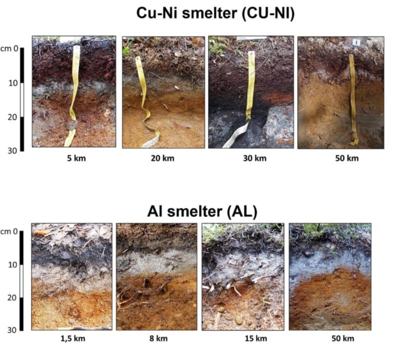Researchers assessed the impact of cities and factories on soil microbial diversity in the Arctic.
The results of the study, funded by a grant from the Russian Science Foundation (RSF), have been published in Geoderma Regional. Arctic soils are undergoing significant changes due to human activities, particularly from mining, metallurgy, and other industrial enterprises, as well as urban development. As a result, soils can accumulate heavy metals, petroleum products, pesticides, and other harmful substances that adversely affect soil microbial communities. Since microorganisms play a crucial role in nutrient cycling—decomposing organic compounds and supplying inorganic nutrients to plants—it is essential to monitor the impact of industrial activities and urban environments on them.
Scientists from the Peoples' Friendship University of Russia named after Patrice Lumumba (Moscow) collaborated with colleagues to employ molecular genetic methods to examine the diversity and abundance of microorganisms in natural, industrially contaminated, and urban soils of the Murmansk region. The authors collected soil samples in Murmansk (the largest city in the region), Apatity (a city with a population five times smaller), as well as near two factories—a copper-nickel plant in the town of Zapolyarny and an aluminum plant in Kandalaksha.
In Murmansk and Apatity, researchers selected samples taking into account the significant spatial diversity of urban soils: in residential areas and public zones across different parts of the cities. In Kandalaksha and Zapolyarny, samples were taken at various distances (from 1.5 to 50 kilometers) from the factories, which are the primary sources of soil contamination. Control samples were taken from conditionally background soils that are not influenced by human activity.
The scientists then determined the chemical composition of the soils. It turned out that soils near the copper-nickel plant contained almost 100 times more nickel and 60 times more copper than natural soils. The soils around the aluminum plant had 22 times more fluorine and aluminum than in natural conditions.
Furthermore, the researchers decoded DNA sequences contained in the samples and assessed the species composition and abundance of soil microorganisms.

The analysis revealed that microbial communities in the soils of Murmansk and Apatity were similar: they were dominated by representatives of the largest bacterial group, Proteobacteria, as well as microscopic ascomycete fungi (Ascomycota). Notably, the number of microorganism species in the soils of urban green zones was 43% higher than in natural soils. One reason for this is that when creating green zones, such as lawns, artificial soil mixtures are used, which contain more carbon and nutrients essential for bacterial life than natural soils. Thus, the urban environment fosters the creation of new niches that enhance microbial diversity.
In industrial areas—near the copper-nickel and aluminum plants—the composition of soil microorganisms was significantly altered compared to natural territories and urban soils distant from the enterprises. Here, microbial diversity was generally reduced, which may indicate a less efficient nutrient cycling and slower decomposition of organic matter in the soil—processes that ensure the stability of the entire ecosystem.
Moreover, in the soils near the copper-nickel plant, the number of actinomycetes—filamentous bacteria—decreased by 31 percent compared to natural soils, while the number of photosynthetic bacteria Chloroflexii and microscopic ascomycete fungi increased 157 times and 1.2 times, respectively. This suggests that these latter groups of microorganisms were the most resilient to soil contamination by nickel and copper.
The soil microbial communities near the aluminum plant exhibited less pronounced changes, with the predominant groups being Proteobacteria and Basidiomycota—fungi that form fruiting bodies with stems and caps.
“As cities and industries are rapidly developing in the Arctic, it is essential to monitor how such activities affect soil microbial communities. This impact must be considered when developing strategies to mitigate the negative consequences of anthropogenic influence and maintain healthy and sustainable Arctic ecosystems. In the future, we plan to study the functional structure of microbial communities in urban ecosystems in more detail and identify key species in various niches.
These species play a crucial role in maintaining the structural integrity of ecosystems, influencing the dynamics and resilience of communities. Additionally, we will investigate how the functional and species structure of microbial communities changes under conditions such as climate warming in the Arctic and the use of anti-icing agents in cities,” says project leader, supported by an RSF grant, Maria Korneikova, PhD in Biological Sciences, senior researcher at the laboratory of Arctic urban ecosystems at the scientific center “Smart Technologies for Sustainable Urban Development in the Context of Global Changes” at the Peoples' Friendship University of Russia named after Patrice Lumumba.
Previously, the authors determined that microorganisms inhabiting the soils of Arctic cities perform chemical transformations of carbon-containing molecules faster than those in natural areas. As a result, urban soils 'breathe' more actively, meaning they release carbon dioxide into the atmosphere, thereby contributing significantly to climate change.
The study also involved staff from the V.V. Dokuchaev Soil Institute (Moscow), the Institute of Geography of the Russian Academy of Sciences (Moscow), the Polar-Alpine Botanical Garden-Institute named after N.A. Avrorin of the Kola Science Center of the Russian Academy of Sciences (Apatity), the Institute of Industrial Ecology of the North of the Kola Science Center of the Russian Academy of Sciences (Apatity), and Wageningen University (Netherlands).